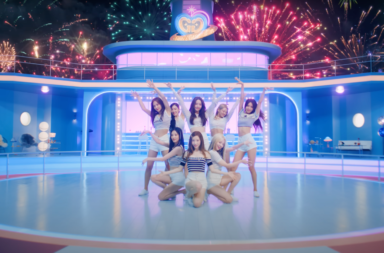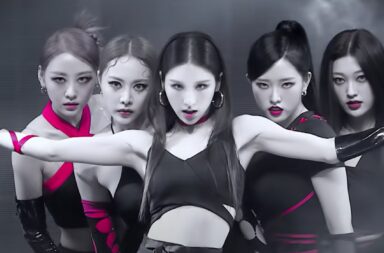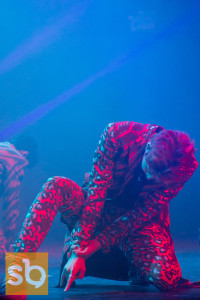 In a slightly quivering network of arms intricately entwined, the six members of VIXX hold formation at the opening of their “Error” choreography. In live performances, their positions are sustained for over twenty seconds, a rare and eerie stillness in a sea of otherwise non-stop dance performances.
In a slightly quivering network of arms intricately entwined, the six members of VIXX hold formation at the opening of their “Error” choreography. In live performances, their positions are sustained for over twenty seconds, a rare and eerie stillness in a sea of otherwise non-stop dance performances.
Right from the beginning we are brought into VIXX’s cyborg world, a place where disparate parts hold together momentarily, only to break apart and then re-form. At first glance, the cyborg concept seems like another in a series of well-executed sci-fi fantasy concepts upon which VIXX has built their reputation. However, beyond the group’s own commentary of the music video, and the “Error” release (including the MV, song, physical album, teasers, photo shoots, etc.) just being flat-out cool, I would argue that a deeper understanding of the figure of the cyborg will also help in a deeper understanding of the significance of “Error.” Not only does such an understanding aid in its interpretation as a work of art, but it is an opportunity for realizing a different way to think about ourselves and our connections to others.
[youtube https://www.youtube.com/watch?v=IF8kySIcWNw]
The landmark essay “A Manifesto for Cyborgs,” by science and technology studies scholar Donna Haraway, lays out why the cyborg (shorthand for cybernetic organism) is a powerful subversive figure. The piece itself is a challenging read, but allow me to summarize some of it its key ideas because it helps in interpreting the cyborg concept’s use in “Error.” Haraway provides us with some central features of cyborg politics:
Cyborg politics is the struggle for language and the struggle against perfect communication, against the one code that translates all meaning perfectly…That is why cyborg politics insist on noise and advocate pollution, rejoicing in the illegitimate fusions of animal and machine (1990: 218).
In short, she argues that the cyborg has the potential to destabilize distinctions of nature/culture, man/woman, human/non-human and many other restricting binaries that she lists in the essay. Haraway champions the cyborg as a means of destroying perceived notions of the types of relationships and identities we are prescriptively given, whether it is the expectations of what a woman or man should be, what groups we should be a part of, or who we should love.
The blurry intermixing and constant imaginative recombination that comes from cyborg technology provides for workable (but never absolute) connections with one another, but also with machines, objects and places. A cyborg existence is much like elements of the K-pop fandom experience. For example, we may coalesce through social media in our fervor for a group, although we are physically in another hemisphere. Or our dedication to the performers is facilitated by a recording played on a little digital device, images of idols brought into our most intimate moments of solitude at home, where we feel like we know them at the same time that we know we’ll never actually know them. These are partial connections and imperfect translations, but they are powerful nonetheless.
This also suggests new ways of communicating. As she says of cyborg imagery, “This is a dream not of a common language, but of a powerful infidel heteroglossia.” Cyborgs represent the individual bleeding into a collective, speaking in many voices and genres, i.e. the “infidel heteroglossia” that Haraway refers to. Heteroglossia is a term with a rich theoretical background, but, suffice to say, it is “the coexistence of, and conflict between, different types of speech.” Speaking in many tongues at the same time, to be intelligible, but not entirely understood, challenges a single authoritative interpretation, hence its infidel qualities. In many ways, the international and multilingual K-pop fandom is itself heteroglossic — another way that fan engagement takes on cyborg qualities. Speedy, functional translations and incomplete but earnest attempts at understanding are part and parcel of a global community of fans and their love of the artists, just as much as this often influences how the artists express themselves.
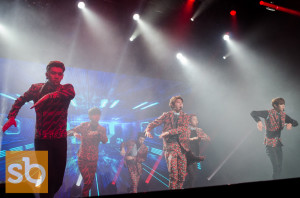 Such a cacophonous blaspheme against a single identity (much like upending designated idol group roles — something VIXX loves to do), and our incomplete yet nonetheless pleasurable/painful commingling embodied in the cyborg, has the potential to break through and reprogram the known social codes and scientific laws that trap us. Armed with a knowledge of the cyborg’s subversive power, let us now return to “Error” itself.
Such a cacophonous blaspheme against a single identity (much like upending designated idol group roles — something VIXX loves to do), and our incomplete yet nonetheless pleasurable/painful commingling embodied in the cyborg, has the potential to break through and reprogram the known social codes and scientific laws that trap us. Armed with a knowledge of the cyborg’s subversive power, let us now return to “Error” itself.
Solely taken as a musical composition, “Error” already reflects the cyborg concept. For starters, the song’s production (courtesy of MeloDesign and Hwang Se-jun) blends electronic sounds with the acoustic instrumentation of guitar, piano and strings. The group’s ability to tightly harmonize vocally (and choreographically), lends itself to the synergistic operation of collective and individual. Kim Eana‘s lyrics forcefully express the desire to both delete and remember. The song invokes the wish to wipe clean memories of pain and trauma of lost love with the line “watch me forget you.” But the suffering stems from the dream to give and receive love; love’s potential failure is the grave risk that accompanies relationship building, even as it offers therapeutic reward. The song’s final verses militate against total erasure, lamenting its impossibility.
The “error” indicates that the process of forgetting is never complete. As lyrics near the end of the song state: “Something went terribly wrong/My heart is still remembering.” Feeling remains and memory resists deletion. Emotions and memories can be re-inserted, once again charging our batteries in the hope of love and connection with one another even if we experienced suffering. Throughout the music video, we see that connection is always partial in consummate cyborg fashion. Hongbin, who plays the protagonist in “Error,” attempts to disconnect himself from his feelings of loss by turning himself into a cyborg. But afterwards he clutches his head as the painful memories of love and loss flicker up involuntarily. He is then driven to re-connect through rendering a cyborg version of his love interest, but she is still incomplete, erroneous. She is not fully formed yet still a functional re-creation.
The other members play a pantheon of partially dismembered cyborgs, their connective edges exposed through tin-man metal panel lines on their faces. Such imagery points back to the patchwork stitches so prominent in their “Voodoo Doll” concept and the way that separate selves and objects are sutured or welded together. The process of union is made visible. The desire to bind things together and reprogram the encoded boundaries that separate us is strong. It is the feeling of disconnection — unplugging like the final dance move in the “Error” choreography — that makes us aware of the need to enjoin and commune.
The closing act of the music video plays this out. The woman cyborg is found to be “illegal,” breaking the codes banning cyborgs from having memories implanted in them. She and Hongbin are only able to escape these restrictions by disintegrating their individual bodies and reforming into a single symbolically powerful mechanical heart. Parts and wholes, machine and emotion are braided together in an act of “illegitimate fusion” per Haraway.
What makes “Error” and its usage of the cyborg even more compelling is that it is not an isolated instance, but rather its most direct and explicit usage. Adopting the cyborg political stance throughout, VIXX’s entire body of work regularly reflects the recurrent themes of partial formation, hopeful connective openness and escapist desire. Most obviously, their genderless mascot Rovix laid the groundwork, a composite of multiple robots, literally a cyborg as a representative for the group. This consistency is also attributable to Hong Won-ki and Zanybros, who play a huge role through their production of all of the group’s music videos to date. In addition, VIXX members’ participation, the conceptual helmsman Yoo Yeon-wook, Nana School‘s choreography, the composers and lyricists, stylists/make-up and the collaborators of their non-MV films (e.g. VIXX TV) have gelled to create an entire body of work suffused with striking thematic cohesion.
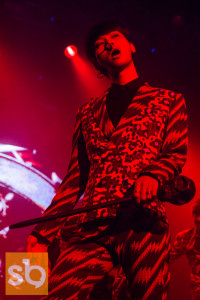 The different elements of the group’s publicly visible productions may at first seem not to speak to each other. However, upon closer examination, their more comedic and “reality” work is very much in conversation with the concerns of the more obviously dark material. For all the gloss and agility, VIXX’s work throughout also reveals its structuring, its fabrication, and its self-awareness. The hands, labor and the tools of their collaborators often become momentarily visible, only to disappear again into the gearbox just below the surface. VIXX is absolutely manufactured, the product of immaculately skillful design, but it is also handicraft, noise and disjuncture, patchwork and improvisatory collective brilliance. Infidel heteroglossia is everywhere in the VIXX universe.
The different elements of the group’s publicly visible productions may at first seem not to speak to each other. However, upon closer examination, their more comedic and “reality” work is very much in conversation with the concerns of the more obviously dark material. For all the gloss and agility, VIXX’s work throughout also reveals its structuring, its fabrication, and its self-awareness. The hands, labor and the tools of their collaborators often become momentarily visible, only to disappear again into the gearbox just below the surface. VIXX is absolutely manufactured, the product of immaculately skillful design, but it is also handicraft, noise and disjuncture, patchwork and improvisatory collective brilliance. Infidel heteroglossia is everywhere in the VIXX universe.
VIXX notably employs cyborg politics to deconstruct the authoritative distinction between master and slave, one that Haraway refers to in her work, but is also an especially significant binary in the world of K-pop. This industry is littered with reports of unjust labor practices, rife with “slave contracts” and the unspoken codes of conduct that idols work under. For VIXX, the frequent use of Hongbin as the focus of visual attention is far from a mistake in this regard. He is one of the members who poignantly personifies mainstream artists’ struggle the between gilded cage and manumission.
For example, Hongbin’s nickname and enactment as “artwork” serves as a tragicomic meta-critique of aesthetic perfection and the necessity of the visual role in idol groups just as much as it celebrates the allure of beauty. In both “Voodoo Doll” and “Error,” Hongbin is the center of desperate escape and fatal captivity. He has been quoted as saying, “Honestly, I have a lot of fears in being an idol. I have to be able to sing, have to be able to dance, and I can’t see my friends … I worried about these things. I also hated how idols are always accused of not being able to sing. I have secretly left the company before.” He has publicly acknowledged his trouble with the weight of idoldom’s obligations and his yearning to run away but is thankful for his reintegration in the group. Just like VIXX’s song “I Don’t Want to Be An Idol,” members’ expressions of reluctant fame and the weighty obligations of designated roles reflect the tensions between deep entanglement and cutting loose, pain and pleasure.
This is lyrically echoed in “Error” with the refrain “Let me free/Let me breathe” and Leo‘s climactic line “There’s nowhere to run from you” accompanied by his choreographic attempt to run as he is held back. Another compelling example of entrapment in an earlier work is evident in “Voodoo Doll,” which has shots showing the members’ imprisonment through an overhead surveillance camera. When they try to break free from this imprisonment, they are also attempting escape from the camera’s gaze. They are visually styled for filmic impact and looking squarely into the camera. Yet, they alternately yearn to break free of the frame.
As early as “Rock Ur Body,” VIXX’s desire for liberation from the screen is evident. Halfway through, the arcade machine breaks down as we hear the repeated line “Come closer.” The screen goes dead and breaking out of the video game a la Wreck-it-Ralph, VIXX is able to, at least for a while, actually come closer to the woman, interacting without the the interference of a screen between them. It reminds me of the moment in “G.R.8.U” when Ravi smashes the television in reverse. This is very much akin to the fantasies of meeting our idols or seeing them live in concert, dreaming of the day when we are no longer separated by a screen, albeit for a few hours. We all wish we could reach through the television to see and touch them in the flesh.
[youtube http://youtu.be/NBbGqq8KDQU]“Error” opens with a flicker screen which recurs. As cyborgs ourselves, are we looking through our own imperfect lenses? Is this the error of the director or editor or some camera malfunction? Is this a brief fissure in continual surveillance? Do we momentarily see through another’s eyes? The source of this glitchiness is unclear. But being jolted out of a lull heightens our feeling of disorientation. Time jumps around, machinery slips up, perspective constantly shifts, the broadcast connection is staticky and unstable. This kind of discontinuity editing functions here to intensify the feeling of partial connection and fraying the edges of seamless editing.
But this technique is not isolated to “Error.” The staticky screen and momentary disconnect is a device used most notably in VIXX TV. VIXX TV1 was the band’s weekly YouTube upload from their debut up until mid-2014. It has since been rebooted as “Season 2” on a fortnightly basis since late September 2014. It is the perfect example of this disruptive glitchiness, where the white noise and its attendant snowstorm image pepper every episode. This indicates breaks in the signal, a loud announcement of an editorial rupture. The opening imitating SMPTE color bars used during dead airtime open every episode with Rovix (and in VIXX TV2 includes Ken‘s illustrations of the members) replicated across each bar.
Along with VIXX TV, many of their film releases and music videos also make use of editing techniques like barn door wipes. Screen wipes make it evident that there is a someone behind the scenes. “Girls, Why?” uses this to wonderful effect, along with other hints at the wizards pulling the levers. The video cleverly makes puppeteers semi-visible and features shadowy hands pushing Ken and Leo around. The music video is a gleeful playground of cyborg themes: breaches of boundaries, the partial connections we make through the telephone and the imperfect translations and gendered miscommunications when trying to say “I love you.”
In the same vein, white noise imagery is everywhere in VIXX’s work. The editor’s presence is never far from the viewer’s mind. The behind the scenes machinations are laid bare like exposed patches of a robotic circuitry but never entirely naked. These editing devices are a moments of communicative failure “against the one code that translates all meaning perfectly.” Disposable metallic body parts strewn about, erratic flickers of the screen and crashes of lightning and thunder suggest that certainty, and continuity is broken. But it doesn’t stop the broadcast, the attempt to find the signal and make contact.
[youtube http://youtu.be/pwnefUaKCbc]In writing about artist Janelle Monae‘s cyborg concept album The ArchAndroid, music critic Ann Powers makes an astute point that its greatness lies in its ability to capture the lived experience of playing multiple roles. This virtuosity is particularly evident in Monae’s ability to flit from genre to genre without skipping a beat. This kind of fast paced role-switching is a “hard-soft dynamic” that is increasingly apparent in pop music because we live in an age that feels more precarious, filled with with riotous violence, “natural” disasters and economic bailouts. Scrolling through all these things on our newsfeeds, Powers says that we must therefore “be ready to hit ‘delete’ and ‘refresh’ and move on,” which is also echoed in contemporary pop music, and yet, in these same songs, she also identifies the hopeful desire to militate against this kind of willful indifference.
I hardly think it is coincidence that Powers’s analysis largely drawn from Monae’s cyborg opus could have easily been written about VIXX’s work. In fact, such a comparison reveals how well Haraway’s conception of the cyborg holds together. When Powers refers to the hard-soft dynamic, she is talking about contradictions in aesthetics, something both beautiful and ugly, a quick and shocking alternation between gentle and thrashing sounds, a moment of static fuzz amidst gleaming clarity. We are once again brought back to the illegitimate fusions so characteristic of the cyborg. Perhaps the most obvious example of VIXX’s display of the hard-soft dynamic aside from “Error” is “Hyde.” The members play multiple roles, toggling between the good and the bad within, battling with things they cannot control in an unforgiving universe, including themselves.
In VIXX’s work, this role-switching is at times painful and overt, at other times silly and playful. Ken’s virtuosic genre switching is a particularly fun instance. He pulls off trot and hip hop with equal aplomb. But having to play multiple roles is always an emotionally loaded process most of us can identify with, wanting to be another person, reaching to get out of the pigeonholes we are stuck in, trying to find some ground to stand on when everything around us seems like it could crumble. Cyborg politics provides us with sharp edge of “delete” and “refresh” required to live in the cruel world that Powers writes about just as much as it provides solace in fusions and connections across great divides. Surrounded by continual uncertainty, breaking free from the roles we are expected to play, subverting rules we have to follow and seizing on meaningful yet imperfect relationships when we find them is how we can endure.
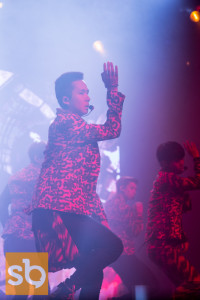 VIXX’s dedication to role play gives us hope. They’ve said before that what sets them apart from the competitive field of idol groups is the commitment to every concept, a full immersion no matter what it calls for. This extends to all of their collaborators whom I also see as an integral part of VIXX’s cyborg ethos. Theirs is an accomplished ongoing commentary that is also the product of an entire team of people who intermittently assert their presence as partially disembodied specters, ghosts in the machine. This assemblage of (in)visible people produce the infidel heteroglossia that is subtly — almost covertly — upending the received wisdom about the kind of imaginative richness and versatility we should expect of an idol group and their collaborators. This would be impossible without their impressive level of coordination and commitment to a consistent vision of artistic expression.
VIXX’s dedication to role play gives us hope. They’ve said before that what sets them apart from the competitive field of idol groups is the commitment to every concept, a full immersion no matter what it calls for. This extends to all of their collaborators whom I also see as an integral part of VIXX’s cyborg ethos. Theirs is an accomplished ongoing commentary that is also the product of an entire team of people who intermittently assert their presence as partially disembodied specters, ghosts in the machine. This assemblage of (in)visible people produce the infidel heteroglossia that is subtly — almost covertly — upending the received wisdom about the kind of imaginative richness and versatility we should expect of an idol group and their collaborators. This would be impossible without their impressive level of coordination and commitment to a consistent vision of artistic expression.
VIXX is a rare and daresay revolutionary group in a formulaic K-pop industry where artists constantly go through a revolving door, where pretty faces and power vocals are a dime a dozen, rapidly made and reproduced, easily replaced when they fail to meet expectation. VIXX faces intensive demands on their labor to constantly re-invent their image for every comeback and withstand examination under the microscope of celebrity. But by bringing us along through every role they create, delete, and then reanimate again, we feel a partial connection to them. Their struggle is also our own struggle to traverse the many worlds we seek to inhabit searching for the utopia where we are “free to be you and me.” VIXX’s mechanized heart still throbs, pumping out the lifeblood of connection and survival, tinkering with tools, destroying and rebuilding from the detritus of the cyborg graveyard.
(YouTube [1][2], Slate, 10Asia, Haraway, Donna. 1990. “A Manifesto for Cyborgs: Science, Technology, and Feminist Socialism in the 1980’s. In Feminism/Postmodernism, Linda J. Nicholson, ed. New York: Routledge. Pp: 190-233., Fry, Paul. 2009. “The Social Permeability of Text.”)
_________
This piece was written by Emily Avera. She was one of the participants of the K-pop Writers’ Workshop. Emily studies anthropology and waxes nostalgic about making cassette mix tapes.
